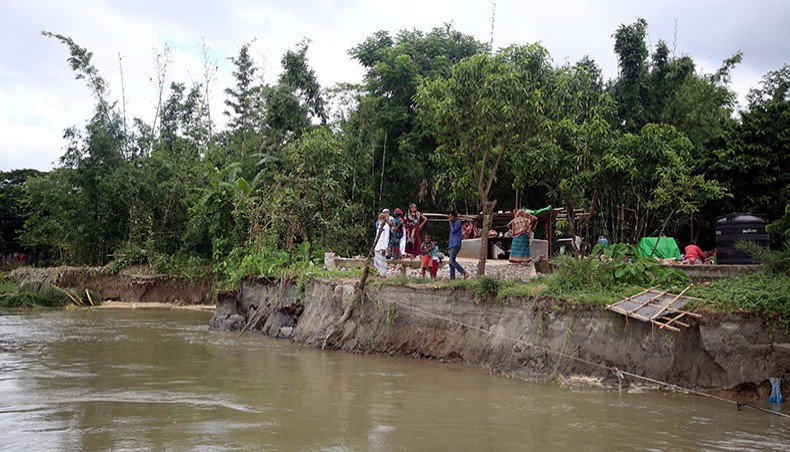
Many Ashrayan villages lost to river erosion

At least 215 families provided shelter under Ashrayan Prakalpa, one of the prime minister’s priority projects, became homeless after rivers devoured two villages created under the project in Jamalpur and Chandpur during the recent flood, according to the project’s initial flood loss estimate.
There were other villages developed under the project elsewhere in the country which have been lost to the swelling rivers during this flood, particularly in Kurigram and Gaibandha, but the project authority’s official account of flood damage sent to the newspapers did not include them.
Dozens of families become homeless almost every year in floods eroding their government-sponsored houses built across Bangladesh without ever carrying out any feasibility studies of the sites.
‘This is right that we never study feasibility of the sites selected for implementing our projects,’ said Ashrayan’s project director Mahbub Hossain.
He said that he came to know from newspaper reports that during the flood some of the houses built under the project got eroded but no study was conducted to measure the extent of the damage to the project.
Dhaka University’s geography and environment professor Maksudur Rahman said that a simple feasibility study could have saved money from being wasted in building villages that lasted only one or two years.
‘It is very much possible to find places through feasibility studies that are unlikely to get lost to river erosion in a decade or even more,’ said Maksud.
He said that the government could easily ask institutions such as CEGIS or Dhaka University for help in this regard.
Initiated in 1997, the Ashrayan Prakalpa is in its 2nd phase set to end in June next year.
The project has so far rehabilitated 3.19 lakh families, 1.65 of them being landless and homeless.
In its first phase, the project spent Tk 908 crore to rehabilitate 1,05,913 families. The 2nd phase will spend more than Tk 4,826 crore.
The project officials said that about half the houses handed over to landless and homeless people would be on the riverside because they always depended on khas land to build them.
The most vulnerable to erosion are those built in shoals, which are largely unprotected against erosion, or on riverside outside embankment.
‘Structures in shoals are always vulnerable to erosion. Shoals are places where kilometers of land can get lost in a single year,’ said Abdul Malek, chairman, Belgachha union, Islampur, Jamalpur.
One of the two villages that the project authorities so far confirmed to have lost to rivers in the flood was in Malek’s constituency.
In Kurigram’s Chilmari, another Ashrayan village disappeared in erosion during this flood, confirmed Abu Hanifa, chairman of Nayarhat union.
The village was completed last year when 150 people were invited to live there. About 50 of them moved to new addresses a few months after they were handed over to them as they got eroded during last year’s flooding.
‘This year the rest of the village disappeared,’ said Hanifa.
A large amount of public money goes to building Ashrayan villages. Currently, the construction of each barrack accommodating five families costs Tk 9 lakh.
Ashrayan villages are clusters of barracks with brick walls and teen roofs.
There were 43 barracks in the villages of Jamalpur and Chandpur which vanished this year.
‘Ashrayan has undoubtedly been a good initiative but it can hardly be called successful,’ said Dhaka University geography and environment professor Nurul Islam Nazem, who researches rural human settlements.
He said that Ashrayan houses are often built in places far away from employment opportunities where landless and homeless people cannot afford to live.
Erosion victims in shoals are more interested in migrating to cities for a living than staying back at home availing government housing opportunities without work, he said.
Nine of the 14 Ashrayan villages in Barguna sadar are on riversides outside the embankments where inhabitants get flooded every now and then.
‘My house is still buried in tons of mud the high tide that hit us ten days ago brought along,’ said Asma, a resident of the Ahsrayan village at Khajurtola, Barguna.
‘Ours is a dangerous home. Waterborne and cold-related diseases are our constant companion,’ she said.
Transparency International Bangladesh executive director Iftekharuzzaman said that the unexpected outcome of a pro-poor initiative was the result of bad governance and a lack of proper planning.
‘This is undermining the high-profile political pledge of the government in general and particularly of the prime minister,’ said Iftekhar.
Dhaka University’s disaster management and vulnerability studies professor Khalid Hasan said that the government should go purchase land for building Ashrayan h
Editor & Publisher: S. M. Mesbah Uddin
Published by the Editor from House-45,
Road-3, Section-12, Pallabi, Mirpur
Dhaka-1216, Bangladesh
Call: +01713180024 & 0167 538 3357
News & Commercial Office :
Phone: 096 9612 7234 & 096 1175 5298
e-mail: financialpostbd@gmail.com
HAC & Marketing (Advertisement)
Call: 01616 521 297
e-mail: tdfpad@gmail.com